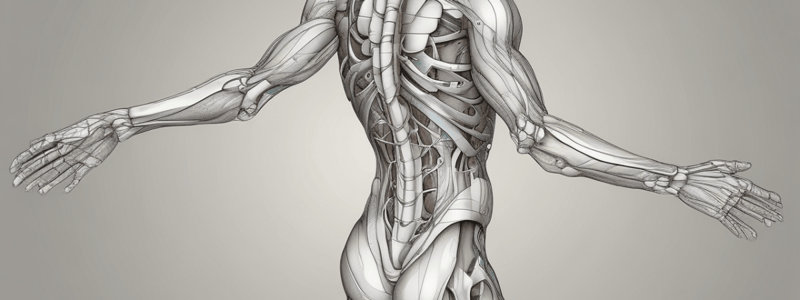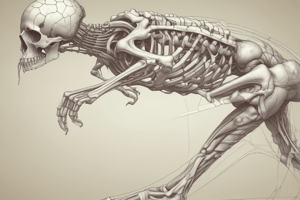Podcast
Questions and Answers
What is the primary reason for the lateral positioning of the femur proximally?
What is the primary reason for the lateral positioning of the femur proximally?
- To support body weight and address the forces of gravity
- To align the hip and knee joints
- To facilitate the opposing thigh muscles to work together
- To increase the range of movement of the hip joint (correct)
What is the average angle of inclination for males?
What is the average angle of inclination for males?
- 130 degrees
- 126 degrees (correct)
- 120 degrees
- 124 degrees
What is the term for an angle of inclination above 130 degrees?
What is the term for an angle of inclination above 130 degrees?
- Angle of anteversion
- Cova vara
- Coxa valga (correct)
- Angle of inclination
What is the significance of a right angle (90 degrees) in the angle of inclination?
What is the significance of a right angle (90 degrees) in the angle of inclination?
What is the purpose of the mechanical axis of the femur?
What is the purpose of the mechanical axis of the femur?
What is the approximate angle of inclination in a 3-year-old?
What is the approximate angle of inclination in a 3-year-old?
What is the term for an angle of inclination below 120 degrees?
What is the term for an angle of inclination below 120 degrees?
Why do females have a slightly smaller angle of inclination compared to males?
Why do females have a slightly smaller angle of inclination compared to males?
What is the primary function of the capsular ligaments of the hip joint?
What is the primary function of the capsular ligaments of the hip joint?
Which of the following is NOT a principal feature of the hip bone?
Which of the following is NOT a principal feature of the hip bone?
What is the main importance of the blood supply to the hip joint in hip fractures?
What is the main importance of the blood supply to the hip joint in hip fractures?
What is the consequence of a hip dislocation on the patient?
What is the consequence of a hip dislocation on the patient?
What is the alignment of the bones in the hip joint related to?
What is the alignment of the bones in the hip joint related to?
What is the primary function of the muscles surrounding the hip joint?
What is the primary function of the muscles surrounding the hip joint?
What is a characteristic of a child with excessive anteversion?
What is a characteristic of a child with excessive anteversion?
What is the primary function of the capsular and intra-capsular ligaments?
What is the primary function of the capsular and intra-capsular ligaments?
What is the characteristic of the hip joint capsule?
What is the characteristic of the hip joint capsule?
What will be discussed in the next section of the lecture?
What will be discussed in the next section of the lecture?
What is a learning outcome of this part of the lecture?
What is a learning outcome of this part of the lecture?
What is the shape of the articular surfaces of the hip joint?
What is the shape of the articular surfaces of the hip joint?
What is the function of the muscles surrounding the hip joint?
What is the function of the muscles surrounding the hip joint?
What is medially rotated?
What is medially rotated?
What is the effect of shortening of the limb on the medial rotators?
What is the effect of shortening of the limb on the medial rotators?
What type of fracture has a better healing outcome?
What type of fracture has a better healing outcome?
Why are elderly females more prone to hip fractures?
Why are elderly females more prone to hip fractures?
What is the consequence of interruption of the blood supply to the head of the femur?
What is the consequence of interruption of the blood supply to the head of the femur?
Why is a hip dislocation a clinical emergency?
Why is a hip dislocation a clinical emergency?
What is the term for thinning of the bones?
What is the term for thinning of the bones?
Why do post-menopausal women have a higher incidence of osteoporosis?
Why do post-menopausal women have a higher incidence of osteoporosis?
What is the significance of the blood supply to the head of the femur?
What is the significance of the blood supply to the head of the femur?
What is the main reason for the capsule's strength?
What is the main reason for the capsule's strength?
How many ligaments are there in total, and from which bones do they arise?
How many ligaments are there in total, and from which bones do they arise?
What is the approximate tensile strength of the iliofemoral ligament compared to reinforced concrete?
What is the approximate tensile strength of the iliofemoral ligament compared to reinforced concrete?
What is the shape of the iliofemoral ligament?
What is the shape of the iliofemoral ligament?
What is the distal attachment of the iliofemoral ligament?
What is the distal attachment of the iliofemoral ligament?
What is the function of the zona orbicularis?
What is the function of the zona orbicularis?
From which ligament does the zona orbicularis arise?
From which ligament does the zona orbicularis arise?
What is the proximal attachment of the pubofemoral ligament?
What is the proximal attachment of the pubofemoral ligament?
Flashcards are hidden until you start studying
Study Notes
Hip Region and Thigh I
- The hip region and thigh consist of the hip bone and femur, which are essential for a wide range of movements.
- The shaft of the femur is pushed laterally away from the joint, and its long neck keeps the shaft well away from the joint, allowing for a wide range of movement.
- The distal end of the femur needs to be more medially placed to support body weight.
Osteology
- The angle of inclination of the femur is 120-130 degrees relative to the shaft, which varies between sexes and ages.
- Females have a wider pelvis, resulting in a slightly smaller angle of inclination (124 degrees) compared to males (126 degrees).
- The angle of inclination changes with age, with newborns having an angle of approximately 160 degrees, and adults retaining a high angulation throughout life.
- An angle above 130 degrees is termed a coxa valga (outward bending), while an angle below 120 degrees is termed a coxa vara (inward bending).
- The closer the angle is to 90 degrees, the less stable the bones are, making them more prone to break.
Angle of Anteversion
- The mechanical axis of the femur aligns the hip and knee joints, requiring lateral rotation of the limb.
- In children, excessive anteversion can result in medial rotation of the limb, leading to splayed limbs.
Supporting Structures
- The hip joint capsule is strong and lax, allowing for a wide range of movement.
- The capsule has three ligaments: iliofemoral, pubofemoral, and ischiofemoral, which attach to the intertrochanteric line.
- The iliofemoral ligament is the strongest ligament in the human body, with a tensile strength 20 times that of reinforced concrete.
- The pubofemoral ligament arises from the pubic margin of the acetabulum and inserts onto the lesser trochanter.
- The ischiofemoral ligament arises from the ischial margin of the acetabulum and inserts into the iliofemoral ligament and the greater trochanter.
Zona Orbicularis
- The zona orbicularis is a circular ligament that arises from the ischiofemoral ligament and serves to pinch the capsule around the neck of the femur, aiding in holding the femoral head into the acetabular socket.
- The zona orbicularis acts like a purse-string, preventing the femoral head from being displaced laterally.
Hip Fractures
- The location of the hip fracture has a bearing on its chances of a successful outcome.
- Intertrochanteric and subtrochanteric fractures are extracapsular and have a better healing outcome.
- Transcervical and subcapital fractures are likely to cause interruption of the joint and have a poorer prognosis.
Blood Supply of the Hip Joint
- Displacement of the femoral head through fracture or dislocation can lead to avascular necrosis, where the blood supply to the head of the femur is interrupted.
- Avascular necrosis can result in the death of the femoral head within 6 hours, making hip dislocation a clinical emergency.
Studying That Suits You
Use AI to generate personalized quizzes and flashcards to suit your learning preferences.




